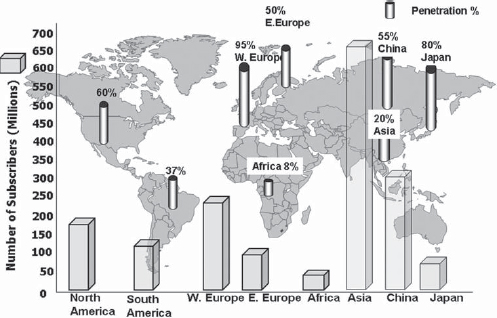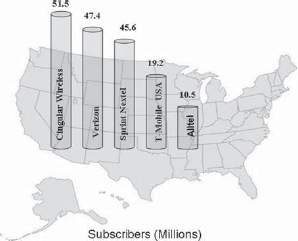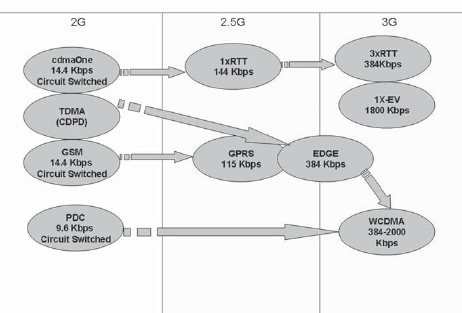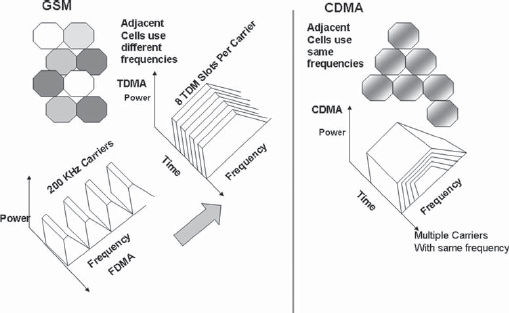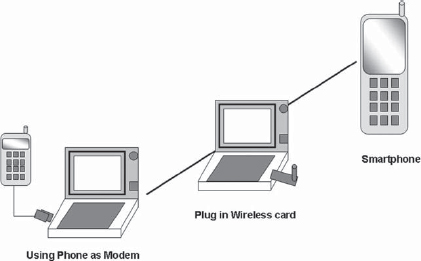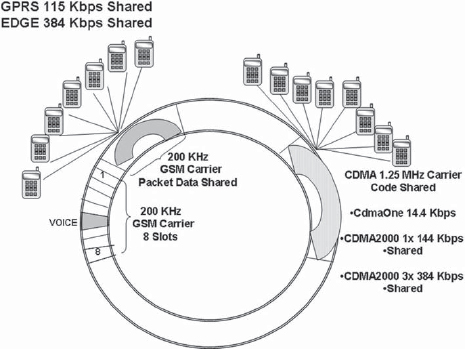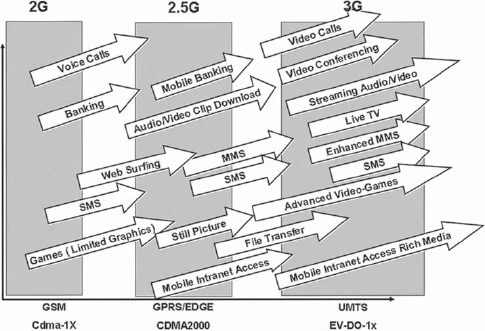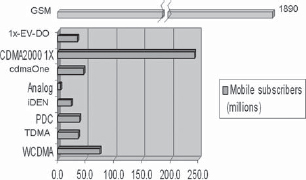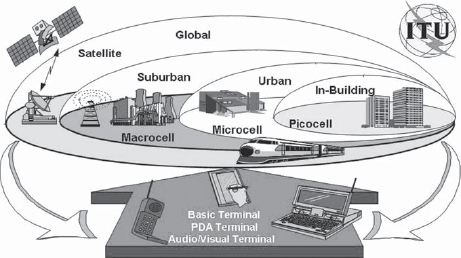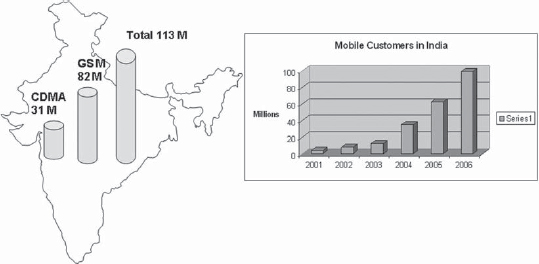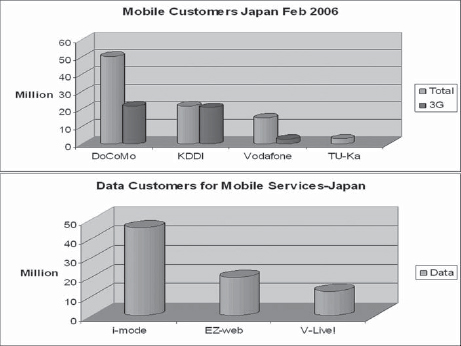OVERVIEW OF CELLULAR MOBILE NETWORKS
You think you understand the situation, but what you don’t understand is that the situation just changed.
—Putnam Investments advertisement
Cellular mobile networks have been the fastest growing segment in the field of telecommunications over the past decade. Over 2.4 billion customers were estimated to use cellular mobile services by the third quarter of 2006. Even with such numbers the cellular industry has a long way to go in terms of both organic growth and continuous introduction of new technologies and services. The reasons are not hard to find. While the penetration rates in some parts of the world (such as Europe, Japan, Korea, and the United States) range between 70 and 100%, the penetration rates in other regions remain very low, such as in Asia (15%), Africa (10%), and South America (20%). It is therefore no surprise that the fastest rates of growth are occurring in these markets. India and China are adding close to 5 million subscribers a month and the regional growth rates average 50–85% for such regions. Globally we have been growing at over 30% per year (Fig. 4-1).
FIGURE 4-1 World Cellular Subscribers
However, it is not these growth rates alone that merit a focus on these markets. The mobile industry is also moving through a great transition. The transition is from pure voice services to those of multimedia, audio and video delivery, games, and Internet and, in fact, the mobile office. The quest to provide these services is also leading to a phase-out of the older generation technologies and a move to a group of select technology streams that are enablers of these services. This makes the mobile field one of the most interesting to follow, as much has been written in the chapters of its brief history.
4.2 CELLULAR MOBILE SERVICES—A BRIEF HISTORY
4.2.1 Analog or First Generation Cellular Systems
The inception of the mobile cellular services dates back to the 1980s when, after technology trials, commercial services were launched using analog technologies. The earlier concept of mobile was its usability in cars, owing to the large size of the receiver, high power consumption, and lack of the technology that provides the light and yet highly efficient batteries that characterize today’s phones. At the time of the introduction of the cellular mobile services, its potential was therefore not truly realized. Because of the high cost of building repeaters, for apparently too few users, as well as technology limitations, it did not become a mass technology in its early implementation.
In the United States the services were launched using the AMPS (Advanced Mobile Phone Service) in 1983. AMPS is a frequency division multiple access (FDMA) technology with analog carriers with a spacing of 30 kHz. Analog services emerged in other countries in quick succession in the ensuing decade. The technologies underlying the various services varied; however, the principles that were established and validated remained much the same in all such service offerings. Cellular mobile services required the use of different frequencies in adjacent cells and this, coupled with the high bandwidth required per frequency (e.g., 30-kHz spacing in the AMPS), quickly consumed large parts of the available spectrum.
In Europe the analog cellular mobile services were introduced based on a number of different systems as well. The Nordic Mobile Telephony (NMT) systems were used in the Nordic countries of Norway, Finland, and Sweden. These were first introduced in the 450-MHz band followed by the 900MHz NMT. In the United Kingdom, Italy, and Spain the TACS (Total Access Communication System) was used. Japan used its own standards, such as NTT, NTACS, and JTACS. Table 4-1 gives a summary of the first generation mobile phone systems used worldwide.
In the United States the FCC licensed two operators in each area, A (wireless) and B (wire line). The analog cellular technologies, despite the use of integrated circuits for voice compression, were an extremely inefficient use of the spectrum. In those countries that saw a rapid growth in analog cellular customers, the frequency bands available were all filled up. In the United States, by 1989, the FCC had granted approvals for 832 frequencies (416 per carrier). These allocations in fact used up part of the 800-MHz UHF band as well. The AMPS systems will be phased out by 1 March 2008 (most are already phased out). In Europe the 1G systems such as TACS and NMT have been fully replaced by 2G cellular systems such as GSM or CDMA (Fig. 4-2).
Analog or First Generation Cellular Mobile Systems
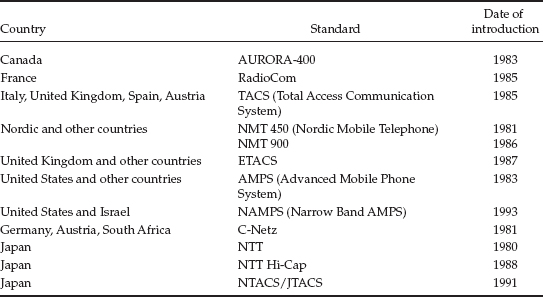
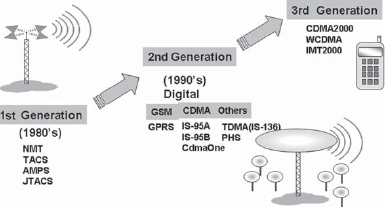
FIGURE 4-2 Cellular System Evolution
4.2.2 Second Generation Cellular Mobile Systems
The AMPS systems were over time partly replaced by digital AMPS systems (D-AMPS), which used time division multiple access (TDMA) technology. D-AMPS, though digital, is still a 2G technology. The Telecommunications Industries Association of the United States approved an interim standard for the TDMA technology known as Interim Standard 54 or IS-54. In addition to the 800-MHz band; spectrum was specifically allocated for the personal communications services (PCS) technologies in the 1900-MHz band. TDMA IS-136 is an update to TDMA IS-54, also called D-AMPS. Carriers such as Cingular Wireless and US Cellular in the United States provide D-AMPS services and are in the process of further migration to CDMA2000 and GSM.
In the meantime GSM became the standard of choice in all European countries as well as a host of other countries around the globe. In mid-2006, GSM claimed 1.9 billion users through over 500 operators in over 210 countries. The use of GSM standards on a large scale also saw global roaming become a reality in the late 1990s.
In 1995, Qualcomm pioneered a digital cellular standard based on CDMA technology. This was standardized under Interim Standard 95 (IS-95), popularly known as cdmaOne. CDMA, as the name suggests, is based on code division multiple access, in which the same frequency is shared by a number of radios, which are distinguished by codes or bit sequences. IS-95 was later supplemented with additional features such as text messaging and circuit-switched data and better compression under the specifications IS-95B. Most networks moved to IS-95B to improve the range of services to be provided to customers. Examples include Cingular Wireless (including AT&T Wireless) and US Cellular.
The number of CDMA customers in 2006 exceeded 370 million and roaming is possible in over 30 countries.
The growth of 2G mobile networks has been largely around these two global standards (with many variants), i.e., GSM and CDMA, and these technologies are so important that their operational capabilities and growth paths merit attention. In the United States, however, there was never a dominant standard for the 2G networks, which had a mix of technologies including CDMA, GSM, TDMA, D-AMPS, and iDEN for the mobile networks. The FCC had permitted “technology neutrality” in the PCS band of 1900 MHz. This implied that any operator having access to the band could use any technology. In part this was responsible for the introduction of GSM services by Voicestream (now a part of T-Mobile). The technology neutrality also enables operators to migrate from TDMA to CDMA2000, 1×EV-DO or 3G–GSM technologies.
4.2.3 GSM Technology
The GSM standard was created in 1987 and was an improvement on the TDMA technologies. GSM uses 200 kHz carriers, each of which uses a time division multiplexed stream with eight slots. The gross data rate in each slot is 270 kbps. GSM is thus a combination of FDMA and TDM technologies. The GSM channel slot had a capacity of 22 kbps per channel (270 kbps gross for eight channels) and also the capability to carry circuit-switched data and fax data.
The spectrum for GSM has been defined for all the three major frequency bands, i.e., 800, 1800, and 1900 MHz (in the United States), and is the most widely deployed technology today. The GSM networks are primarily circuit-switched networks, though packet-switched data capabilities have been added in most networks through enhancements to the core network (such as GPRS overlay).
GSM uses speech encoding based on the regular pulse excitation linear predictive coder, which gives encoded speech bit rates of 13, 12.2, and 6.5 kbps. The modulation used is GMSK (Gaussian minimum shift keying).
GSM transmit and receive carriers operate in paired frequency bands. Following is an example of GSM parameters for a UK operator:
• frequency band 1710–1785 MHz mobile Tx, 1805–1880MHz base Tx;
• Channel spacing 200 kHz, 374 carriers, 8/16 users per carrier.
4.2.4 Mobile Networks Worldwide
Soon after the launch of the cellular mobile services, it had become apparent that the mobile services had an excellent projection for growth. However, it was only after the launch of GSM services in the 1990s, the emergence of global roaming, and the increasing use of nonvoice features such as SMS and e-mail that the true potential of the mobile services began to be realized.
The initial growth was highest in the United States (Fig. 4-3), Europe, and Japan, followed by the rest of Asia, with the result that the penetration levels of mobile networks reached close to 100% in Western Europe. The growth markets have now shifted to China (with 400 million subscribers), Russia (100 million), and India (115 million).
FIGURE 4-3 Top U.S. Cellular Operators
GPRS is an overlay packet-switched network on the circuit switch-based GSM networks. The GPRS network uses the existing carrier frequencies and does not require the use of new spectrum. In GPRS one of the TDM carriers with 8 slots (270 kbps gross rate) is dedicated to packet-switched data. This enables a 115-kbps packet data carrier to be available, which can be used on a shared basis by devices that are GPRS enabled. This provides an “always on” data connection to the devices and eliminates the unacceptable delays in circuit-switched connections.
The packed-switched data under lightly loaded conditions can allow the users to get 50-kbps downlink/20-kbps uplink data speeds (depending on simultaneous users) and makes applications such as e-mail, SMS, MMS, and exchange of video and audio clips feasible.
The GPRS applications are not limited to cell phones. GPRS-enabled cards are being used in PDAs, notebook and laptop computers, and fax machines. The use of tunneling protocols makes possible applications in private networks as well.
The use of GPRS is made possible by the addition of the Serving GPRS support node and the Gateway GPRS support node. These nodes interact with the Home Location Register node to obtain subscriber profile and authentication information. The Gateway GPRS support node can interface with external data networks, which include the X.25-based networks as well as the IP networks.
The GPRS technology had for the first time a provision for classes of traffic, with four Quality of Service (QoS) classes being defined based on sensitivity to delays. Streaming live audio or video can be given a higher priority than packets carrying data for other applications, such as background applications or file transfer. The packets with higher QoS can be transmitted first with a higher priority over the packets for other services.
The next evolution toward higher data rates is the Enhanced Data Rates for GSM Evolution (EDGE). The EDGE networks introduce new technologies at the physical layer, such as 8PSK modulation, and better protocols for data compression and error recovery. The higher layer protocols remain largely the same. With 200-kHz radio channels (same as that in GPRS or GSM), EDGE networks have the capability to deliver gross data rates of up to 500 kbps per carrier. This data rate is a shared pool of bandwidth for all the users using the pool and is available under ideal transmission conditions with a good signal. Owing to the pool nature of the capacity one user can thus on the average expect to get no more than 200 kbps (Fig. 4-4).
It is estimated that over 500 GSM operators were providing services in 2006, including 270 GPRS operators and over 180 EDGE operators, giving an indication of the strong drive toward data services.
4.5.1 2G Technologies—cdmaOne
The cdmaOne cellular services, as the name suggests, are based on the use of code division multiple access technologies. The standards for the CDMA-based mobile services were first standardized as IS-95 and the services provided are known under this notation. The IS-95 standard initially published in 1993 was revised in 1995 to IS-95A, with added features, and is the basis of most cdmaOne networks worldwide.
FIGURE 4-4 Data Rates in Cellular Mobile Systems
cdmaOne uses a carrier bandwidth of 1.25 MHz to provide the services using code division multiple access. The frequency bands of 800 and 1900MHz are both used. The use of code division multiplexing has many advantages such as use of common frequencies in adjacent cells, soft handoffs, and higher tolerance due to multipath fading as well as interference.
CDMA technologies have many unique features owing to the use of spread spectrum techniques, which distinguish them from the GSM or TDMA technologies (Fig. 4-5). First, in FDMA systems (including GSM), the neighboring cells cannot use the same frequencies. This places tough design requirements as in actual situations there can be irregular radio propagation, which can result in interference or nonusability of certain frequencies. In CDMA all cells can use the same frequencies without any specific allocation of cell-wise resources. This makes the radio system easy to design and robust.
Further, in spread-spectrum systems such as the CDMA, multipath propagation is not a problem as the reflected waves received from all sources are added to receive the final signal. Frequency specific fading has very little effect on the overall system performance. Moreover in CDMA the handoff between cells is a soft handoff because the switching of the frequencies from one cell to another is not required. cdmaOne can support data transmission on a circuit-switched basis at speeds up to 14.4 kbps.
4.5.2 2.5G and 3G CDMA Services: CDMA2000
The limitations of cdmaOne led to the evolution toward 2.5G systems with better capabilities for handling of data and higher capacities for voice. The first stage in the evolution was the 1×RTT system, which is the specification of the system using 1.25 MHz carriers. The 1×RTT air interface comprises two channels. The fundamental channel is an 8-kHz channel (with 9.6 kbps raw data rate) and carries signaling, voice, and low-data-rate services. This is the basic channel assigned for every session. The second channel is the supplemental channel (SCH), with a data rate of 144 kbps (153.2 kbps gross), and carries traffic in burst modes. The channel capacity is dynamically assigned to different users who can get data rates of 19.2, 38.4, etc., up to 144 kbps. The SCH channel is IP based and thus provides efficient support of multiple devices and applications. The CDMA technologies provide for higher capacity of the system owing to better data compression and modulation techniques as well as the structure of the channels employed. The privacy and security are also enhanced in CDMA2000 technologies. The CDMA2000 networks can operate on the same carriers as cdmaOne as an overlay network.
The next stage of evolution of CDMA services is the 3×RTT, which essentially indicates the use of 3 × 1.25 MHz carriers. The 3×RTT technology can provide support of data up to rates of 384 kbps.
4.6 HANDLING DATA AND MULTIMEDIA APPLICATIONS OVER MOBILE NETWORKS
The handling of data and mobile applications has always been of interest to users. In the 1G world (analog cellular systems) the only way was to use analog connections using modems for data. The bandwidth used for data was the same as used for voice. As the voice encoders work in the range of 8–13 kbps, these effectively set the data rate limit at 9.6 kbps or lower in the analog world. This, though inadequate by today’s standards, sufficed for applications not involving use of multimedia. User devices appeared that took advantage of the data capabilities and had applications such as mail and microbrowsers built in (Fig. 4-6).
The induction of 2G technologies brought in the capabilities of circuit-switched data without the use of an analog modem, which was limited in speed due to the voice encoder used in the mobile phones.
4.6.1 Data Capabilities of GSM Networks
At the time of design and initial rollout of the cellular mobile networks the data transmission capabilities were not so much in focus as they have become as time passed on. The networks were designed essentially for voice, with focus on high efficiency in bit rate encoding. Video technology had not advanced sufficiently to make highly compressed video (e.g., H.264) a reality on the mobile networks. Only circuit-switched data capabilities were added in the 2G systems, while IP data capabilities were added in the 2.5G networks such as GPRS under the GSM umbrella and CDMA2000 1×RTT in the CDMA domain.
FIGURE 4-6 Handling Data over Mobile Networks
4.6.2 SMS
The GSM networks support SMS on the signaling channel. SMS has been equally as popular as the use of the GSM phones themselves. GPRS also carries SMS in data packets rather than signaling channels as this enhances the capacity of the system in terms of messaging capabilities.
4.6.3 Circuit-Switched Data or Fax
A circuit-switched call can be placed on the GSM network at speeds of 9.6 or 14.4 kbps. The connection is similar to using a circuit-switched modem call. In recent networks the support for high-speed circuit-switched data services has been added, which permits data calls up to 38 kbps.
FIGURE 4-7 Data Handling over 2G and 2.5G Networks
The 2G networks, both GSM and CDMA (cdmaOne), had been designed essentially for voice communications. The circuit-switched data in the networks is limited to either 9.6 or 14.4 kbps. This is good enough to support applications such as e-mail and browsing but not sufficient for handling video and audio (Fig. 4-7).
Another shortcoming that severely restricted the use of data services in 2G networks was the need to set up data connections. The need of most applications, e.g., e-mail or streaming, is always on connectivity, which could be achieved only through packet-based networks.
The 2.5G networks overcame these limitations to an extent. The GPRS for example provides a shared bearer of 115 kbps, which needs to be shared on an average among eight users. Even the CDMA2000 1×, which gives a shared data rate of 144 kbps, can get severely limited in actual per user speeds on simultaneous usage, with users getting only 70–80 kbps on average.
FIGURE 4-8 Development of Applications on Mobile Networks
The 2.5G networks, despite various enhancements such as IP-based connectivity, QoS, and class-of-traffic-based traffic handling, continued to suffer from serious shortfalls with respect to capacity limitations. The number of simultaneous users, particularly at peak times, has the potential to degrade the service. The actual data rate usable thus depends on the number of simultaneous users and also their locations within the cell sites. Users at the edge of the cell will get a lower data rate due to transmission impairments of the higher modulation scheme signals.
To enable the use of rich media applications involving video clips, audio downloads, or browsing Web sites with multimedia content, the 2G and even 2.5G technologies needed to be improved and the migration toward 3G was seen as the only way forward (Fig. 4-8).
4.6.4 Wireless Access Protocol (WAP)
The use of mobile screens needed a new hypertext coding language as the normal Web pages were unsuitable for viewing on mobile screens.
FIGURE 4-9 Mobile Subscribers in 2006, by Technology
The WAP specifications were designed by the WAP forum in 1995 as a wireless markup language (WML) which was an evolution from the XML. The primary target of WAP was the delivery of text-based information with the capability to handle monochromatic images as well.
WAP was designed to work with most cellular networks, including IS-95, cdmaOne, CDMA2000, GSM, GPRS, and EDGE, as well as 3G implementations. Despite an initially promising picture, WAP failed to find a strong favor among the users. It required them to connect to WAP-enabled Web sites while many applications started developing around SMS exchanges, which turned out to be the dark horse of mobile applications. A variant of WAP called the i-mode packet data transfer service was introduced by NTT DoCoMo in 1999. The service used CWML (compact wireless markup language) instead of WAP WML for data display. The i-mode service had almost 46 million customers in the beginning of 2006 (Fig. 4-9).
4.7 3G NETWORKS AND DATA TRANSMISSION
3G networks have been developed as per global standards agreed upon under the auspices of the ITU under the International Mobile Telephone 2000 (IMT2000) initiative. The IMT2000 envisages the use of macrocells, microcells, and picocells with predicted data rates possible. IMT2000 defines data speeds of 144 kbps at driving speeds, 384 kbps for outside stationary use or walking speeds, and 2 Mbps indoors (Fig. 4-10).
FIGURE 4-10 The IMT2000 Vision (Courtesy of the ITU)
The 3G networks were designed specifically to address the needs of multimedia, i.e., streaming of video and audio clips and access to rich interactive multimedia Web sites. The 3G Partnership Project (3GPP) was formed to coordinate all aspects of 3G networks internationally, including multimedia file formats, resolutions, coding standards, and transmission air interfaces, so as to have a global compatibility in standards for the new generation of mobile services.
3G network design resolves the data limitations of earlier versions by assigning a larger bandwidth for the carrier, typically 5 MHz. The key advantage of the 3G networks lies in the fact that the networks are based on IP and, depending on their location, the users can expect to be able to use up to 2 Mbps of data throughput.
The 3G architecture represents a major evolution over the 2G architecture of GSM and 2.5G overlays of GPRS and EDGE. The 3G networks use an IP-based core and this represents a complete evolution from the 2G circuit-switched core networks. The core network protocols support video and voice-over IP with quality-of-service guarantees. The support of the IP multimedia system is a part of the 3GPP initiatives.
WCDMA (wideband code division multiple access) is the main technology or air interface used in the 3G systems. The 2 × 5-MHz paired band for WCDMA can support a raw channel data rate of 5.76 Mbps, which translates into data rates of up to 2 Mbps per user (dependent on network design).
Mobile Customers by Bearer Technology
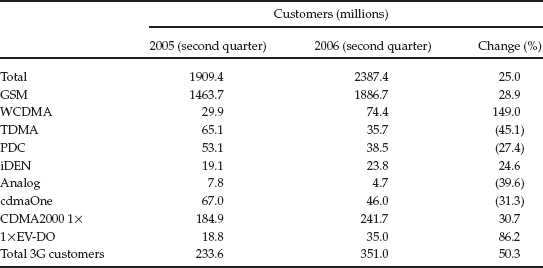
The number of 3G subscribers (CDMA2000, WCDMA, and 1×EV-DO networks) was estimated at over 350 million at mid-2006 through over 150 operational networks. The period June 2005 to June 2006 witnessed striking growth in 3G customers, with the number growing by over 50%. The trend is expected to continue as more countries, particularly in Asia, bring their 3G networks onstream.
Table 4-2 shows a sharp decline in cdmaOne customers primarily because of the upgradation to CDMA2000 and EV-DO networks in the United States and Korea. The 2G GSM numbers continue to show strong growth, primarily originating in India, China, and Brazil.
The technology trends witnessed during 2006 indicate that the TDMA and D-AMPS may now be considered legacy technologies and are in a phase-out mode by most carriers (Fig. 4-11). The migration is heading toward 3G (WCDMA) or 1×EV-DO. An analysis of global trends shows that the GSM family of customers had grown by 400 million in 2005 and by a further 500 million in 2006. The CDMA customers numbered 251 million at the end of 2005 and numbered around 375 million by mid-2006. The migration to the 3G networks is happening very rapidly, with growth in CDMA2000 being 33%, WCDMA 150%, and 1×EV-DO 100%.
FIGURE 4-11 Mobile Subscribers—Technology Trends
4.8 MOBILE NETWORKS—A FEW COUNTRY-SPECIFIC EXAMPLES
4.8.1 The United States of America
Beginning with the analog AMPS service in 1983, the United States has had a steady growth of mobile users with a mix of technologies. These include D-AMPS and TDMA as successors to AMPS as well as CDMA technologies for which the United States has been the stronghold. GSM has been a late entrant to the U.S. market but is now making strong progress.
The United States had over 160 million mobile users by mid-2006. The mobile market in the United States, which has traditionally been a mix of technologies, has been witnessing rapid phase-out of legacy systems (such as analog AMPS, D-AMPS, and TDMA) and introduction of GSM as well as CDMA2000 networks. EV-DO has also been introduced by all major CDMA carriers in metro areas. HSDPA had been deployed by 10 operators by early 2006 after the launch of the first HSDPA service by Cingular in 2005. 3G-UMTS services are now being deployed by T-Mobile.
Table 4-3 gives the current status of the U.S. carriers.
4.8.2 India
Cellular mobile services commenced in India in 1995–1996 after the issue of licenses for GSM-based cellular mobile services in 1994. The licenses initially granted to two operators were subsequently issued to the state-owned operators BSNL and MTNL and also a fourth operator for operation in the 1800-MHz band. Licenses were also issued to broaden the scope of CDMA services, which were initially permitted as a fixed wireless service, into a full-fledged mobile service.
India has since then witnessed a very sharp growth in the number of customers. The growth averaged 85% every year from 1999 to 2006, surpassing the growth rates in any other market, including China, where despite a 400 million customer base the growth was only 16% in 2005–2006. The number of mobile customers in India in July 2006 stood at 113 million using CDMA and GSM services. CDMA customers were 31 million in number and GSM customers were 82 million. Major operators for CDMA include Reliance, Tata Indiacom, and BSNL, while those for GSM are Bharti, BSNL, MTNL, Hutch, Idea Cellular, and Escotel (Fig. 4-12).
The major GSM operators (Bharti, Hutch, BSNL, and Idea) have already introduced data services through GPRS and EDGE. All the CDMA operators (Reliance Infocom, Tata Teleservices, and BSNL) are providing CDMA2000 services with high-speed data access facility on their handsets (Fig. 4-13).
Cellular Mobile Operators in the United States of America
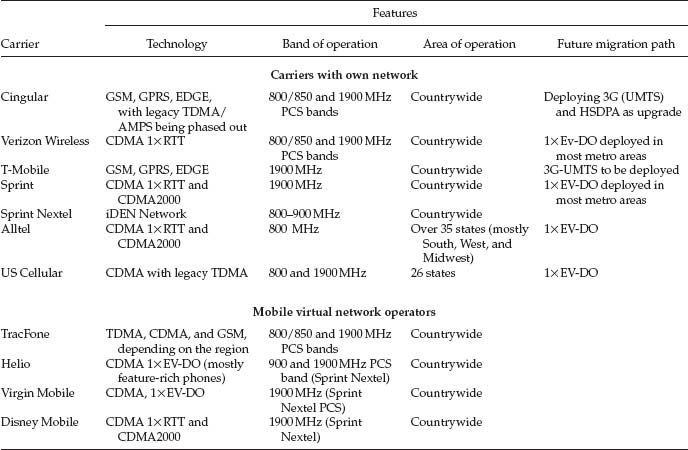
FIGURE 4-12 Cellular Mobile Customers in India (July 2006)
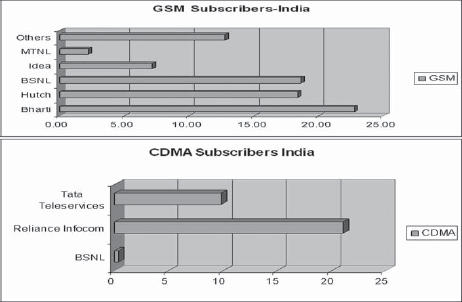
FIGURE 4-13 Indian Cellular Mobile—Major Operators
Korea needs a special mention in the field of mobile communications because of its innovative approach to introduction of new services. Korea has three major operators, Korea Telecom, KTF, and LG Telecom. The largest mobile phone company in Korea is Korea Telecom (KT). KT had garnered 20 million subscribers as early as 1993 when other countries in Asia were just beginning to introduce cellular services. It has a subsidiary company, KTF, which provides CDMA services and has over 15 million subscribers. KT also has a broadband service with Wi-Fi hot spots (NESPOT) and, taking advantage of this, KT has introduced a dual-mode Wi-Fi and CDMA2000/1×EV-DO terminal at which the customers can use Wi-Fi when in a coverage area or fall back to 1×EV-DO. KT also has a premium wireless broadband mobile network, WiBro.
4.8.4 Japan
Two of the major operators in Japan have their origin in the telephone operating companies NTT and KDDI, for domestic and international communications, respectively. The new mobile company NTT DoCoMo operates the largest network using WCDMA technology, while the KDDI has a largely CDMA2000 network, which has been upgraded to 1×EV-DO. Japan was an early starter in 3G services. Japan was in fact the first country to deploy the 3GPP-compliant network by Jphone in 2002. FOMA (Freedom of Mobile Multimedia Access) from NTT DoCoMo began in Oct 2002, based on WCDMA technology. The rich interactivity provided in services such as FOMA has led to a very rapid growth in the number of 3G services as well. Subscriber data from February 2006 revealed over 45 million subscribers to Japan’s 3G services (Fig. 4-14).
NTT DoCoMo operates the 3G FOMA service, which has proved very popular because of the rich range of services.
Migration to 3G networks is one of the most important trends today. As per a projection by strategy analytics in 2006, the 3G subscribers will exceed those of 2G by 2008. This crossover has already happened in Korea and Japan and is expected shortly in Europe and the United States. This will bring into greater focus the emerging mobile multimedia, live TV, gaming, and other applications, which remain constrained by the current generation of 2G networks.

